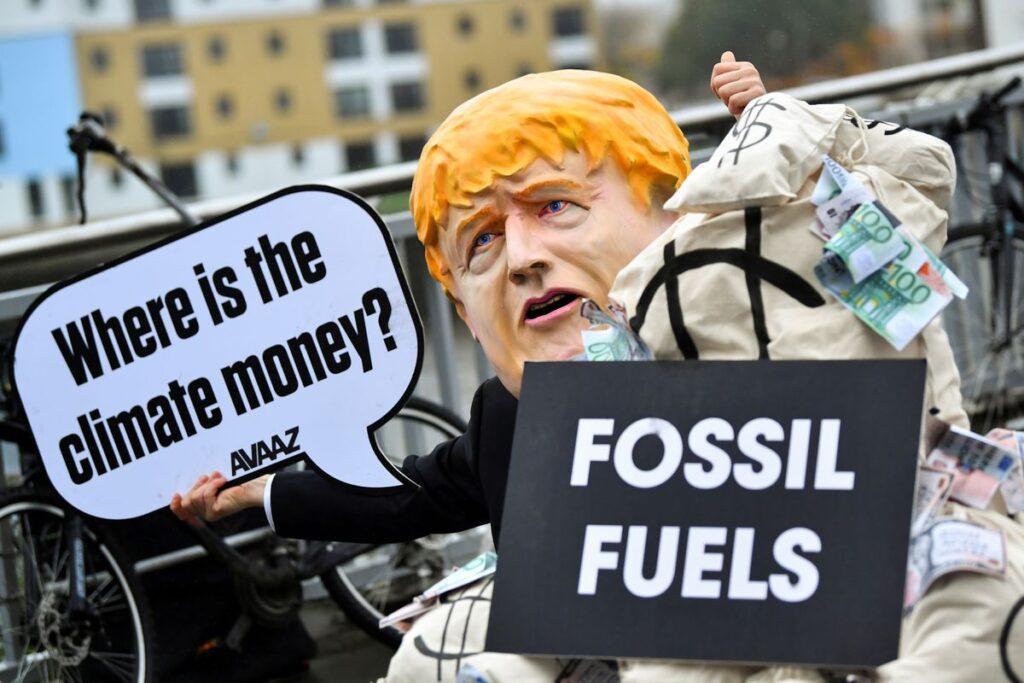COP26: Feats, Foibles And Failures
Nov 13, 2021 | Shalini Rai
FILE PHOTO: A person wearing a mask depicting Britain's Boris Johnson protests during the UN Climate Change Conference (COP26) in Glasgow, Scotland, Britain on November 12, 2021 (Reuters)
The UN Climate Change Conference (COP26) drew to a close yesterday, Friday, November 12. When it began, almost two weeks ago, on Sunday, October 31, people around the world had hoped that the summit will result in meaningful changes to the status quo. But the high hopes invested in the summit and its delegates now stand dashed.
Let’s go through what has been agreed at COP26, Glasgow, Scotland. A series of agreements between groups of countries have been announced so far, including:
- The US and China agreed to work together this decade to limit global temperature rise to 1.5C, in a surprise announcement
- A new alliance that commits countries to setting a date to ending oil and gas use – and halting granting new licences for exploration – was launched
- More than 40 countries committed to move away from coal – but the world’s biggest users like China and the US did not sign up
- More than 100 world leaders promised to end and reverse deforestation by 2030, including Brazil, home to the Amazon rainforest
- The US and the EU announced a global partnership to cut emissions of the greenhouse gas methane by 2030 – reducing methane in the atmosphere is seen as one of the best ways to quickly reduce global warming
As is evident, the unwillingness of both the US and China to move away from coal shows the half-baked nature of their efforts towards arresting global warming. Yet another alliance was launched, this time needing commitment from countries to set a date for ending oil and gas use. In a surprising turn of events, China and US agreed to work together to limit global temperature rise to 1.5C.
While these might appear to be positive steps forward, their actual effectiveness will depend on the sincerity and commitment of participating nations towards averting global warming and preventing adverse climate change.
The indisputable sticking points are the fact that climate finance remains a distant dream, that animal agriculture was not even on the COP26 agenda, that meat was served at a summit purporting to espouse the cause of limiting global warming and the fact that despite the promises made at COP26 so far, the planet is still heading for 2.4C of warming above pre-industrial levels.
Climate finance, or the money promised by richer countries to poorer countries to fight climate change, continues to be one of the most contentious points. In 2009, developed nations pledged to provide $100bn per year to emerging economies by 2020. But this target was not met.
Another major concern is greenhouse gas emissions from animal agriculture. Raising livestock generates 14.5 per cent of global greenhouse gas emissions that are very bad for the environment. But this crucial topic was not even on the agenda of the COP26. It speaks volumes about the sincerity and commitment of the summit towards making a real change to the current climatic scenario.
An aside but one which reveals a lot about the optics of the summit is the fact that meat was served during meals at the summit headquarters in Glasgow, Scotland. While this may appear to be a non-issue, it shows with just how much seriousness delegates and participating nations treat each factor — in this case, meat consumption, that contributes greatly to global warming and has a huge carbon footprint — that contributes to adverse climate change.
Unsurprisingly, despite the promises made at COP26 so far, the planet is still heading for 2.4C of warming above pre-industrial levels, according to a report by Climate Action Tracker.
As regards India’s approach to the summit, PM Narendra Modi spelt out a five-fold plan on November 2. It is as follows:
- India’s non-fossil energy capacity would reach 500 GW by 2030
- It will meet 50% of its electricity requirements with renewable energy by 2030
- It will reduce its total projected carbon emissions by a billion tonnes by 2030
- It will reduce the carbon intensity of its economy to less than 45%
- Achieve net zero emissions target by 2070
Net zero is when a country’s carbon emissions are offset by taking out equivalent carbon from the atmosphere, so that emissions in balance are zero. However, achieving net zero by a specific date means specifying a year, also called a peaking year, following which emissions will begin to fall.
Meanwhile, NDCs or Nationally Determined Contributions are voluntary targets that countries set for themselves, which describe the quantum and kind of emission cuts they will undertake over a fixed period to contribute to preventing runaway global warming. India’s last NDC was submitted following the Paris Agreement of 2015. Before COP26 began on October 31, countries were expected to provide updated NDCs. India, however, did not furnish one.
This points to the fact that for most participating nations, economic growth and development takes precedence over preventing adverse climate change and taking steps to limit global warming. First, the 1997 Kyoto Protocol, then the 2015 Paris Agreement and finally, the COP26 — nations of the world come together at regular intervals to thresh out agreements and frameworks that ostensibly make the right noises and deliver politically-correct speeches.
However, how much of a difference and real-time change this brings about can be deduced from the achievements and non-achievements that have underscored the COP26 climate summit.
